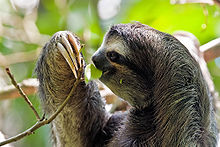Pilosa
| Pilosa[1] | |
|---|---|

| |
| Giant anteater, Myrmecophaga tridactyla | |

| |
| Brown-throated sloth, Bradypus variegatus | |
| Scientific classification | |
| Domain: | Eukaryota |
| Kingdom: | Animalia |
| Phylum: | Chordata |
| Class: | Mammalia |
| Superorder: | Xenarthra |
| Order: | Pilosa Flower 1883 |
| Families | |
The order Pilosa is a group of placental mammals, extant today only in the Americas. It includes the anteaters and sloths, including the extinct ground sloths, which became extinct about 10,000 years ago. The name comes from the Latin word for "hairy".[2] Pilosans are good examples of ecological harmony. Anteaters, for example, feed lightly and for a short time at any one ant nest, allowing the colony to regrow easily. Also, sloths' fur is home to many insects, as well as a type of alga that helps camouflage the sloths.[3]
Origins and taxonomy
The biogeographic origins of the Pilosa are still unclear,[4] but they can be traced back in South America as far as the early Paleogene (about 60 million years ago, only a short time after the end of the Mesozoic Era). The presence of these animals in Central America and their former presence in North America is a result of the Great American Interchange. A number of sloths were also formerly present on the Antilles, which they reached from South America by some combination of rafting or floating with the prevailing currents.
Together with the armadillos, which are in the order Cingulata, pilosans are part of the larger superorder Xenarthra, a defining characteristic of which is the presence of xenarthrals (extra formations between lumbar vertebrae). In the past, Pilosa was regarded as a suborder of the order Xenarthra, while some more recent classifications regard Pilosa as an order within the superorder Xenarthra. Earlier still, both armadillos and pilosans were classified together with pangolins and the aardvark as the order Edentata (meaning toothless, because the members do not have front incisor teeth or molars, or have poorly developed molars). Edentata was subsequently realized to be polyphyletic; it contained unrelated families and was thus invalid.
Classification
Taxonomy

Order Pilosa
- Suborder Vermilingua Illiger 1811 em. Gray 1869(Anteaters)
- Family Cyclopedidae Pocock 1924 (Silky anteaters)
- Family Myrmecophagidae Gray 1825
- Suborder Folivora Delsuc et al. 2001[5] (Sloths)
- Superfamily †Megalocnoidea Delsuc et al. 2019
- Family †Megalocnidae Delsuc et al. 2019 (megalocnid ground sloths of the Caribbean)
- Superfamily Megatherioidea Gray 1821
- Family Bradypodidae Gray 1821 (three-toed sloths)
- Family †Megalonychidae Gervais 1855 (megalonychid ground sloths)
- Family †Megatheriidae Gray 1821 (megatheriid ground sloths)
- Family †Nothrotheriidae Ameghino 1920 (nothrotheriid ground sloths)
- Family †Schismotheriinae McKenna & Bell 1997
- Superfamily Mylodontoidea Gill 1872
- Family Choloepodidae Pocock 1924 (two-toed sloths)
- Family †Mylodontidae Gill 1872 (mylodontid ground sloths)
- Family †Nematheriidae Mercerat 1891
- Family †Orophodontidae Ameghino 1895
- Family †Scelidotheriidae Ameghino 1889 (scelidotheriid ground sloths)
- Superfamily †Megalocnoidea Delsuc et al. 2019
Phylogeny
Major families within Pilosa[5]
| |||||||||||||
Cladogram of living Pilosa[5][6][7]
References
- ^ Gardner, A. L. (2005). "Order Pilosa". In Wilson, D. E.; Reeder, D. M. (eds.). Mammal Species of the World: A Taxonomic and Geographic Reference (3rd ed.). Johns Hopkins University Press. pp. 100–103. ISBN 978-0-8018-8221-0. OCLC 62265494.
- ^ Kidd, D.A. (1973). Collins Latin Gem Dictionary. London: Collins. p. 248. ISBN 0-00-458641-7.
- ^ George A. Feldhamer; Lee C. Drickamer; Stephen H. Vessey; Joseph F. Merritt; Carey Krajewski (1 January 2015). Mammalogy: Adaptation, Diversity, Ecology. JHU Press. pp. 343–. ISBN 978-1-4214-1588-8.
- ^ A proposed clade, Atlantogenata, would include Xenarthra and early African mammals.
- ^ a b c Presslee, S.; Slater, G. J.; Pujos, F.; Forasiepi, A. M.; Fischer, R.; Molloy, K.; Mackie, M.; Olsen, J. V.; Kramarz, A.; Taglioretti, M.; Scaglia, F.; Lezcano, M.; Lanata, J. L.; Southon, J.; Feranec, R.; Bloch, J.; Hajduk, A.; Martin, F. M.; Gismondi, R. S.; Reguero, M.; de Muizon, C.; Greenwood, A.; Chait, B. T.; Penkman, K.; Collins, M.; MacPhee, R.D.E. (2019). "Palaeoproteomics resolves sloth relationships". Nature Ecology & Evolution. 3 (7): 1121–1130. doi:10.1038/s41559-019-0909-z. PMID 31171860.
- ^ Miranda, Flávia R.; Casali, Daniel M.; Perini, Fernando A.; Machado, Fabio A.; Santos, Fabrício R. (2018). "Taxonomic review of the genus Cyclopes Gray, 1821 (Xenarthra: Pilosa), with the revalidation and description of new species". Zoological Journal of the Linnean Society. 183 (3): 687–721. doi:10.1093/zoolinnean/zlx079.
- ^ Gibb, Gillian C.; Condamine, Fabien L.; Kuch, Melanie; Enk, Jacob; Moraes-Barros, Nadia; Superina, Mariella; Poinar, Hendrik N.; Delsuc, Frédéric (2015). "Shotgun Mitogenomics Provides a Reference PhyloGenetic Framework and Timescale for Living Xenarthrans". Molecular Biology and Evolution. 33 (3).
